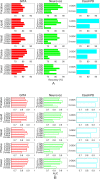Phonetic relevance and phonemic grouping of speech in the automatic detection of Parkinson's Disease
- PMID: 31836744
- PMCID: PMC6910953
- DOI: 10.1038/s41598-019-55271-y
Phonetic relevance and phonemic grouping of speech in the automatic detection of Parkinson's Disease
Abstract
Literature documents the impact of Parkinson's Disease (PD) on speech but no study has analyzed in detail the importance of the distinct phonemic groups for the automatic identification of the disease. This study presents new approaches that are evaluated in three different corpora containing speakers suffering from PD with two main objectives: to investigate the influence of the different phonemic groups in the detection of PD and to propose more accurate detection schemes employing speech. The proposed methodology uses GMM-UBM classifiers combined with a technique introduced in this paper called phonemic grouping, that permits observation of the differences in accuracy depending on the manner of articulation. Cross-validation results reach accuracies between 85% and 94% with AUC ranging from 0.91 to 0.98, while cross-corpora trials yield accuracies between 75% and 82% with AUC between 0.84 and 0.95, depending on the corpus. This is the first work analyzing the generalization properties of the proposed approaches employing cross-corpora trials and reaching high accuracies. Among the different phonemic groups, results suggest that plosives, vowels and fricatives are the most relevant acoustic segments for the detection of PD with the proposed schemes. In addition, the use of text-dependent utterances leads to more consistent and accurate models.
Conflict of interest statement
The authors declare no competing interests.
Figures








References
-
- Pfeiffer, R. F., Wszolek, Z. K. & Ebadi, M. Parkinson’s Disease (CRC Press, 2013).
-
- Moro Velázquez, L. Towards the differential evaluation of Parkinson’s Disease by means of voice and speech processing. Ph.D. thesis, ETSIS Telecomunicacion - Universidad Politecnica de Madrid (2018).
Publication types
MeSH terms
LinkOut - more resources
Full Text Sources
Medical

